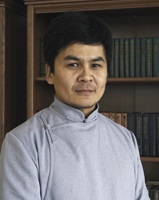Интонационные средства выражения завершенности в тувинском фольклорном повествовании
DOI:
https://doi.org/10.25178/nit.2025.2.8Ключевые слова:
тувинский язык; интонация; завершенность; интонационная универсалия; фольклорАннотация
Представленное исследование является продолжением нашей предыдущей работы, посвященной интонации тувинских фольклорных текстов, , результатом которой стал анализ комплекса интонационных средств, выступающих в роли маркеров значимых разделов текста. Целью данной статьи является изучение проявления в тувинском языке интонационных универсалий, связанных с выражением законченности повествовательных высказываний. Новизну проделанного исследования составляет то, что способы маркирования завершённости высказывания не становились ранее предметом отдельного исследования, проводимого с применением корпусных и статистических методов. Теоретической и методологической базой исследования являются устоявшиеся в российском языкознании принципы выделения единиц интонации, основанные на методе выявления оппозиций и многоаспектном анализе высказывания как синтаксической единицы.
В качестве основного материала исследования используются аудиозаписи четырёх фольклорных текстов на тувинском языке, которые были разделены на высказывания и проаннотированы с помощью программного обеспечения Praat. Полученный таким образом корпус был проанализирован с целью выявления просодических характеристик, которые могут рассматриваться как значимые с точки зрения выражения законченности высказывания. При анализе учитывались как синтаксическая структура рассматриваемых высказываний, так и их роль в формировании фольклорного текста.
В результате исследования был выделен ряд интонационных конструкций, реализующихся в текстах, каждая из которых ассоциирована с определенными коммуникативными функциями. Это позволило продемонстрировать использование интонации для противопоставления финальных и нефинальных компонентов высказываний. Результаты анализа показали, что завершенность высказывания обычно выражается нисходящим движением тона и падением интенсивности, однако имеются несколько примеров ровного или восходящего тона в конце высказывания в контекстах, в которых требуется подчеркнуть необходимость дальнейшего продолжения выраженной высказыванием мысли. Полученные выводы согласуются с предыдущими исследованиями интонации тюркских языков Сибири и подтверждают универсальность употребления нисходящего тона для обозначения завершенности высказывания.
Библиографические ссылки
Бавуу-Сюрюн, М. В. (2010) Тувинский язык на современном этапе: образовательный аспект // Новые исследования Тувы. № 3. С. 57–71.
Бельский, А. В. (1956) Интонация как средство детерминирования и предицирования в русском литературном языке // Исследования по синтаксису русского литературного языка : сб. статей / отв. ред. В. П. Сухотин. М. : Изд-во Академии наук СССР. 200 c. С. 188–199.
Бичелдей, К. А. (1989a) Гласные тувинского языка в потоке речи : в 2-х ч. Кызыл : ЦОП «Тувинское республиканское управление статистики». Ч. I. 91 с.
Бичелдей, К. А. (1989b) Гласные тувинского языка в потоке речи : в 2-х ч. Кызыл : ЦОП «Тувинское республиканское управление статистики». Ч. II. 94 с.
Бичелдей, К. А. (2001) Фарингализация в тувинском языке. М. : Изд-во РУДН. 290 с.
Брызгунова, Е. А. (1971) О смыслоразличительных возможностях русской интонации // Вопросы языкознания. № 4. С. 42–52.
Брызгунова, Е. А. (1973) Основные типы интонационных конструкций и их функционирование в русском языке. Статья первая // Русский язык за рубежом. № 1. С. 75–81.
Дамбыра, И. Д. (2005) Вокализм каа-хемского говора в сопоставлении с другими говорами и диалектами тувинского языка / отв. ред. И. Я. Селютина. Новосибирск : ИД «Сова». 224 с.
Исхаков, Ф. Г., Пальмбах, А. А. (1961) Грамматика тувинского языка. Фонетика и морфология. М. : Изд-во восточной литературы. 472 с.
Кечил-оол, С. В. (2006) Типологическая специфика консонантизма сут-хольского говора в системе говоров и диалектов тувинского языка / отв. ред. И. Я. Селютина. Новосибирск : ИД «Сова». 361 с.
Наделяев, В. М. (1980) Артикуляционная классификация гласных // Фонетические исследования по сибирским языкам : сб. науч. тр. / отв. ред. В. М. Наделяев. Новосибирск : Институт истории, филологии и философии СО АН СССР. 164 с. С. 3–91.
Наделяев, В. М. (1986) К типологии артикуляционно-акустических баз (ААБ) // Фонетические структуры в сибирских языках : сб. науч. тр. / отв. ред. Е. И. Убрятова. Новосибирск : Институт истории, филологии и философии СО АН СССР. 188 с. С. 3–15.
Николаева, Т. M. (1977) Фразовая интонация славянских языков. М. : Наука. 278 с.
Николаева, Т. M. (1984) Функциональный синтаксис и семантика. Интонация. Диахроническое языкознание. Обращение к фразовой просодии: параллели и расхождения // Актуальные вопросы интонации : сб. науч. тр. / отв. ред. В. И. Петрянкина. М. : Изд-во УДН. 133 с. С. 3–16.
Ооржак, Б. Ч., Аннай, Э. К., Ондар, Ч. Г., Саая, О. М. (2024) Функционирование тувинского и русского языков в Республике Тыва: опыт анализа // Научное обозрение Саяно-Алтая. № 1 (41). С. 64–73. DOI: https://doi.org/10.52782/KRIL.2024.1.41.006
Румянцев, М. К. (1997) Эмоциональные интонации в языках разной типологии // Международная конференция по языкам Дальнего Востока, Юго-Восточной Азии и Западной Африки. М. : ИСАА. С. 29–33.
Рыжикова, Т. Р., Добринина, А. А, Плотников, И. М., Шестера, Е. А, Шамрин, А. С. (2020) Интонация модальных вопросительных высказываний в алтайском языке (на материале фольклора алтай-кижи) // Сибирский филологический журнал. № 2. С. 149–165. DOI: https://doi.org/10.17223/18137083/71/13
Светозарова, Н. Д. (1982) Интонационная система русского языка. Ленинград : Изд-во Ленинградского ун-та. 175 с.
Симчит, К.-М. А. (2016) Тувинский язык // Большая российская энциклопедия / отв. ред. С. Л. Кравец. М. : Большая российская энциклопедия. Т. 32. 767 с. C. 473–474.
Уртегешев, Н. С., Селютина, И. Я., Добринина, А. А., Рыжикова, Т. Р. (2021) Фонетические трансформации в аналитических формах тюркского глагола / отв. ред. И. В. Шенцова. Новосибирск : Академиздат. 252 с.
Успенский, Б. А. (1965) Структурная типология языков. М. : Наука, 286 с.
Хромов, С. С. (2013) Интонация как универсалия // Вестник Волгоградского государственного университета. Сер. 2: Языкознание. № 1 (17). С. 84–91.
Черемисина, Н. В. (1982) Русская интонация: поэзия, проза, разговорная речь. М. : Русский язык. 207 с.
Щербак, А. М. (1994) Введение в сравнительное изучение тюркских языков. СПб. : Наука ; Санкт-Петербург. изд. фирма. 191, [1] с.
Янко, Т. Е. (2008) Интонационные стратегии русской речи в сопоставительном аспекте. М. : Языки славянских культур. 312 с.
Bolinger, D. L. (1964) Intonation as a universal // Proceedings of the Ninth International Congress of Linguists (Cambridge (Mass.), Aug. 27–31, 1962) / ed. by H. G. Lunt. The Hague : Mouton & Co. xxii, 1174 p. P. 833–848.
Bolinger, D. L. (1978) Intonation across languages // Universals of human language / ed. by J. H. Greenberg. Stanford : Stanford University Press. Vol. 2: Phonology. xvi, 590 p. P. 471–524.
Brown, D. E. (1991) Human universals. N. Y. : McGraw-Hill. x, 220 p.
Buht, W., Aginsky, E. G. (1948) The importance of language universals // Word. Vol. 4, no. 3. P. 168–172. DOI: https://doi.org/10.1080/00437956.1948.11659339
Cohen, A., Collier, R., t’ Hart, J. (1982) Declination: Construct or intrinsic feature of speech pitch? // Phonetica. Vol. 39, no. 4–5. P. 254–273. DOI: https://doi.org/10.1159/000261666
Cooper, W. E., Sorensen, J. M. (1981) Fundamental frequency in sentence production. N. Y. ; Heidelberg ; Berlin : Springer-Verlag. x, 213 p. DOI: https://doi.org/10.1007/978-1-4613-8093-1
Cruttenden, А. (1981) Falls and rises: Meanings and universals // Journal of Linguistics. Vol. 17, no. 1. P. 77–91. DOI: https://doi.org/10.1017/S0022226700006782
Daneš, F. (1960) Sentence intonation from a functional point of view // Word. Vol. 16, no. 1. P. 34–54. DOI: https://doi.org/10.1080/00437956.1960.11659719
Ferguson, Ch. A. (1963) Assumptions about nasals; a sample study in phonological universals // Universals of language / ed. by J. H. Greenberg. Cambridge, MA : The MIT Press. x, 269 p. P. 42–47.
Fernandez-Vest, M. M. J., Van Valin, R. D. Jr. (еds.). (2016) Information structuring of spoken language from a cross-linguistic perspective. Berlin : Mouton de Gruyter. vi, 333 p. DOI: https://doi.org/10.1515/9783110368758
Greenberg, J. H. (1962) Is the vowel-consonant dichotomy universal? // Word. Vol. 18, no. 1–3. P. 73–81. DOI: https://doi.org/10.1080/00437956.1962.11659766
Greenberg, J. H. (1963a) Some universals of grammar with particular reference to the order of meaningful elements // Universals of language / ed. by J. H. Greenberg. Cambridge, MA : The MIT Press. x, 269 p. P. 58–90.
Greenberg, J. H. (еd.). (1963b) Universals of language. (Report of a conference held at Dobbs Ferry, New York, April 13–15, 1961). Cambridge, MA : The MIT Press. x, 269 p.
Gussenhoven, C. (2002) Intonation and interpretation: Phonetics and phonology // Speech Prosody 2002 : Proceedings of the 1st International Conference on Speech Prosody (Aix-en-Provence, April 11–13, 2002) / ed. by B. Bel, I. Marlien. Aix-en-Provence : Laboratoire Parole et Langage ; SProSIG. xvii, 742 p. P. 47–57.
Gussenhoven, C. (2004) The phonology of tone and intonation. Cambridge : Cambridge University Press. xxiv, 355 p.
Gussenhoven, C., Chen, A. (2000) Universal and language-specific effects in the perception of question intonation // Proceedings of the 6th International Conference on Spoken Language Processing / еd. by B. Yuan, T. Huang, X. Tang. Beijing : China Military Friendship Publish. Vol. 2. P. 91–94.
Gussenhoven, C., Gösta, B. (1999) Word prosody and intonation // Word prosodic systems in the languages of Europe / ed. by H. van der Hulst. Berlin ; N. Y. : Mouton de Gruyter. xxix, 1050 p. P. 233–271.
Hockett, Ch. F. (1963) The problem of universals in language // Universals of language / ed. by J. H. Greenberg. Cambridge, MA : The MIT Press. x, 269 p. P. 1–22.
Jakobson, R. (1962) The phonemic concept of distinctive features // Proceedings of the Fourth International Congress of Phonetic Sciences (University of Helsinki, September 4–9, 1961) / ed. by A. Sovijärvi, P. Aalto. The Hague : Mouton & Co. xxix, 825 p. P. 440–455.
Johanson, L. (1998) The history of Turkic // The Turkic languages / ed. by L. Johanson, É. Á. Csató. L. ; N. Y. : Routledge. xxiii, 474 p. P. 81–125.
Ladd, D. R. (2001) Intonational universals and intonational typology // Language typology and language universals : An international handbook / ed. by M. Haspelmath, E. König, W. Oesterreicher, W. Raible. Berlin ; N. Y. : Mouton de Gruyter. 1856 p. P. 1380–1390.
Lévi-Strauss, C. (1966) The savage mind. Chicago : The University of Chicago Press ; L. : Weidenfeld and Nicolson Ltd. xii, 290 p.
Liberman, M., Pierrehumbert, J. (1984) Intonational invariance under changes in pitch range and length // Language sound structure: Studies in phonology presented to Morris Halle by his teacher and students / ed. by M. Aronoff, R. T. Oehrle. Cambridge, MA : The MIT Press. xii, 392 p. P. 157–233.
Lieberman, Ph. (1967) Intonation, perception, and language. Cambridge, MA : The MIT Press. xiii, 210 p.
Lindau, M. (1986) Testing a model of intonation in a tone language // The Journal of the Acoustical Society of America. Vol. 80, no. 3. P. 757–764. DOI: https://doi.org/10.1121/1.393950
Murdock, G. P. (1959) Africa: Its peoples and their culture history. N. Y. : McGraw-Hill. xiii, 456 p.
Ohala, J. J. (1983) Cross-language use of pitch: An ethological view // Phonetica. Vol. 40, no. 1. P. 1–18. DOI: https://doi.org/10.1159/000261678
Ohala, J. J. (1994) The frequency code underlies the sound-symbolic use of voice pitch // Sound symbolism / ed. by L. Hinton, J. Nichols, J. J. Ohala. Cambridge : Cambridge University Press. x, 373 p. P. 325–347. DOI: https://doi.org/10.1017/CBO9780511751806.022
Pike, K. L. (1945) The intonation of American English. Ann Arbor : University of Michigan Press. xi, 200 p.
Ryzhikova, T. R., Dobrinina, A. A., Plotnikov, I. M., Shestera, E. A., Shamrin, A. S. (2021) Intonation structuring of coherent Tuvan folklore narration // Новые исследования Тувы. № 4. С. 101–118. DOI: https://doi.org/10.25178/nit.2021.4.8
Ryzhikova, T. R, Dobrinina, A. A., Plotnikov, I. M. (2020) Preliminaries to the Tuvan interrogative intonation // ExLing 2020 : Proceedings of the 11th International Conference of Experimental Linguistics (12–14 October 2020, Athens, Greece) / ed. by A. Botinis. Athens : National and Kapodistrian University of Athens. vi, 237 p. P. 165–168. DOI: https://doi.org/10.36505/ExLing-2020/11/0041/000456
Ryzhikova, T. R., Plotnikov, I. M., Shamrin, A. S. (2021) Intonation of the Khakas fairytales // ExLing 2021 : Proceedings of the 12th International Conference of Experimental Linguistics (11–13 October 2021, Athens, Greece) / ed. by A. Botinis. Athens, National and Kapodistrian University of Athens. viii, 277 p. P. 197–200. DOI: https://doi.org/10.36505/ExLing-2021/12/0050/000523
Troubetzkoy, N. S. (1949) Principes de phonologie. Paris : Librairie C. Klincksieck. xxxiv, 396 p. (In Fr.).
Van Valin, R. D. Jr. (1999) A typology of the interaction of focus structure and syntax // Typology and linguistic theory: From description to explanation / ed. by E. V. Rakhilina, Ya. G. Testelets. Moscow : Languages of Russian Culture. 639 p. P. 511–524.
Van Valin, R. D. Jr., LaPolla, R. J. (1997) Syntax: Structure, meaning, and function. Cambridge : Cambridge University Press. xxviii, 713 p. (Cambridge Textbooks in Linguistics).
Опубликован
Как цитировать
Ryzhikova T. R., Plotnikov I. M., Dobrynina A. A. and Ondar Ch. G. Intonational means of expressing finality in Tuvan folklore narration. New Research of Tuva, 2025, no. 2, pp. 144-168. DOI: https://doi.org/10.25178/nit.2025.2.8
Для цитирования:
Ryzhikova T. R., Plotnikov I. M., Dobrynina A. A. and Ondar Ch. G. Intonational means of expressing finality in Tuvan folklore narration // Новые исследования Тувы. 2025. № 2. С. 144-168. DOI: https://doi.org/10.25178/nit.2025.2.8
Выпуск
Раздел

Это произведение доступно по лицензии Creative Commons «Attribution-NonCommercial» («Атрибуция — Некоммерческое использование») 4.0 Всемирная.

Автор (лицензиар) произведения предоставляет простую (неисключительную) лицензию на использование редакцией (лицензиатом) произведения науки, который заключается в упрощённом порядке (открытая лицензия), согласно ст. 1286.1. «Открытая лицензия на использование произведения науки, литературы или искусства» Гражданского кодекса Российской Федерации.
В нашем издании публикуемые материалы доступны по лицензии Creative Commons «Attribution-NonCommercial» («Атрибуция — Некоммерческое использование») — CC BY-NC.
Т. к. лицензия открытая, автор имеет право разместить статью после ее выхода на своем сайте, читатель может скопировать и разместить на своих персональных ресурсах, в том числе в виде выдержек, конспектов, но:
а) обязательно должно быть указано ФИО автора, неизмененное название статьи и гиперссылка на первоисточник (журнал «Новые исследования Тувы»),
б) размещающий не имеет права брать деньги за доступ к этому материалу или каким бы то ни было образом давать преимущество одним читателям над другими,
в) при перепечатке автором текста статьи без значительных изменений (если сохраняется 30% текста или более) должно быть указано, что первая редакция статьи вышла в журнале «Новые исследования Тувы» и сделана соответствующая ссылка.
Лицензия действует по всему миру, длится в течение срока авторских прав на произведение, является неотзывной.












